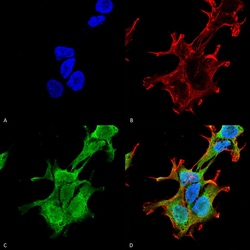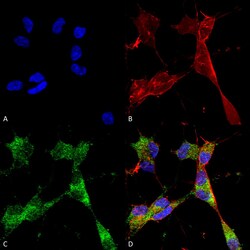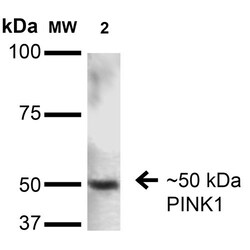Learn More
Invitrogen™ PINK1 Monoclonal Antibody (N4/15), FITC
Mouse Monoclonal Antibody
Supplier: Invitrogen™ MA545656
Description
82% identical to rat and 81% identical to mouse. >30% identity with DMPK. 1 μg/mL of MA5-45656 was sufficient for detection of PINK1 in 20 μg of rat brain lysate by colorimetric immunoblot analysis using Goat anti-mouse IgG:HRP as the secondary antibody. Detects approximately 50kDa. This antibody was formerly sold as clone S4-15.
PINK1 (PTEN-induced putative kinase 1) protects from mitochondrial dysfunction in cells by conferring different autophosphorylation activity to mitochondrial genes. The kinase domain of PINK1 appears to be critical in its protective effects. Mitochondrial proteins are critical for the regulation of cellular energy and adaptation to stress. Particularly in brain cells, mitochondrial demand is extraordinarily high, in order to accommodate aerobic and anaerobic support of high energy processes. When mitochondrial structure and/or function is disrupted in the brain, neurodegenerative diseases like Parkinson's disease are triggered.
Specifications
| PINK1 | |
| Monoclonal | |
| 1 mg/mL | |
| PBS, 9.09mM sodium bicarbonate with 640.91mM DMSO, 136.36mM ethanolamine and no preservative; pH 7.4 | |
| B5DFG1, Q99MQ3, Q9BXM7 | |
| PINK1 | |
| Fusion protein amino acids 112-496 (cytoplasmic C-terminus) of human PINK1. | |
| 100 μg | |
| Primary | |
| Human, Mouse, Rat | |
| Antibody | |
| IgG1 |
| Immunohistochemistry, Western Blot, Immunocytochemistry | |
| N4/15 | |
| FITC | |
| PINK1 | |
| 1190006F07Rik; AU042772; AW557854; BRPK; FLJ27236; mFLJ00387; PARK6; PINK 1; Pink1; PINK-1; protein kinase BRPK; PTEN induced putative kinase 1; PTEN-induced putative kinase protein 1; Serine/threonine-protein kinase PINK1, mitochondrial | |
| Mouse | |
| Protein G | |
| RUO | |
| 298575, 65018, 68943 | |
| 4°C, store in dark | |
| Liquid |
Safety and Handling
Your input is important to us. Please complete this form to provide feedback related to the content on this product.


